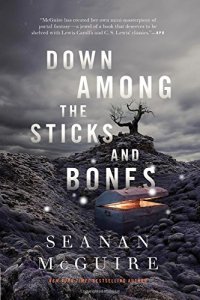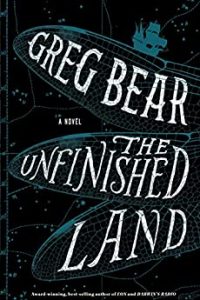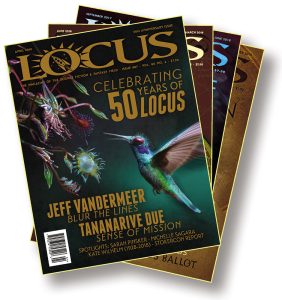The Final Orchard by C. J. Rivera : Review by Paul Di Filippo
 The Final Orchard, C.J. Rivera (Angry Robot 978-1915998262, trade paperback, 400pp, $18.99) November 2024
The Final Orchard, C.J. Rivera (Angry Robot 978-1915998262, trade paperback, 400pp, $18.99) November 2024
As her CV informs us: until now, C.J. Rivera’s creative output has occurred in media other than print, making this not only her debut novel, but apparently her debut prose fiction of any sort. (ISFDB believes so too.) But we need fear not, because her skills earned elsewhere translate to a rousing good tale benefiting from a vivid cinematic lensing and staging. Future books from her will only get better, I am sure.
It’s a dystopia, but of a certain sort. I often think of dystopias as either “intentional” or “circumstantial.” Intentional dystopias are those where human agency alone has created the horrible world. Orwell’s 1984 is obviously the template. Circumstantial dystopias are really a kind of post-collapse scenario. The future is horrid, but it’s due to nonhuman causes, such as environmental degradation. Individual people might set themselves up as tinpot overlords in vest-pocket authoritarian enclaves, but it’s seldom for ideological reasons, but rather out of sheer dog-eat-dog survivalism. Recall that section of Things to Come involving the Boss.
Rivera’s book is of the circumstantial sort. Our planet (presumably our planet, though the lack of familiar place names might be a clue otherwise) is falling to pieces, and in the midst of this, a megalomaniacal scientist-cum-businessman conceives of creating a Last Redoubt with some passing resemblance to The Island of Doctor Moreau—except that humans are the only “animals” thereon.
We start out with a common-enough incident. A woman—a mother, a scientist—is driving too fast to a meeting in heavy traffic. Her name is Rosio Arata. In the back seat of her car is her young daughter, Rune. Little tidbits of data let us know this is a futuristic milieu. For one thing, high-tech mechanical prosthetics are everywhere, both for practical and ornamental reasons. Now comes a mild spoiler, occurring in this very first chapter. The car crashes, the mother survives, the daughter dies.
Our narrative immediately switches to the POV of another character, a teenaged girl named Ever. At first, her revealed culture—living underground in an enormous complex named the Helix, and having many strange customs and social roles and castes—leads us to believe that Ever might be inhabiting Rosio’s future. Whether this conjecture is true or not, I shan’t reveal. Suffice it to say that Rivera eventually brings both narrative locomotives on their separate tracks to a frightful collision.
On “Ro’s” track, we watch her descend into drunken despair, the scientific revelation she had been rushing to share in chapter one now going to waste. But eventually that aforementioned Elon Musk-type fellow, Edric Easton, contacts her and convinces Ro to come work for him. His goal? To replace inorganic prostheses with organic ones, lab-grown limbs, skin, etc. Easton holds out one very potent lure: if Ro is nicely compliant, maybe he’ll help her clone Rune, a better-than-nothing replacement for the dead daughter. She reluctantly agrees, but soon finds that she is virtually a prisoner. And she begins to suspect that Easton’s plans revolve around more than mere body parts.
Meanwhile, Ever and her friends struggle to obey the strict directives of their mysterious Chairman. He is training the children to ascend to the Surface, where alien invaders—the Forms—currently rule. These children will become Saviors, and recapture the planet for humanity. But not all the test subjects continue to buy blindly into this program. Reed, Ever’s boyfriend, is especially heretical, and tries to convince Ever to run away with him, reach the Surface, and find out the truth for themselves. When they do make a break, their odyssey to reach aboveground runs a gamut of obstacles—human and inanimate—that would test an Odysseus. Can they even get out of the trap-studded Helix?
Rivera is pretty merciless with her kill rate, and the survivors of her authorial executions attain only a bitter prize. And yet the effect of the book is not nihilistic or defeated. Both Ever and Rosio perform to the top of their abilities without ever losing hope. An admirable goal for us all.
Rivera’s worldbuilding is better inside the Helix—which has a great claustrophobia-inducing feel akin to such famous pocket universes as Gene Wolfe’s Long Sun books—than it is for the world at large. The business of mechanical prostheses as status symbols is only minimally explored, and we get little sense of how citizens and society have adapted to their hothouse planet.
But the two halves ultimately cohere to a compelling whole, which echoes the feel and themes of a George Lucas film. How so, given no space opera trappings? I’m referring to his earliest masterpiece, THX 1138. The message there—conformity is death—rings as loudly now, in Rivera’s book, as it did 50 years ago.
Interested in this title? Your purchase through the links below brings us a small amount of affiliate income and helps us keep doing all the reviews you love to read!
 While you are here, please take a moment to support Locus with a one-time or recurring donation. We rely on reader donations to keep the magazine and site going, and would like to keep the site paywall free, but WE NEED YOUR FINANCIAL SUPPORT to continue quality coverage of the science fiction and fantasy field.
While you are here, please take a moment to support Locus with a one-time or recurring donation. We rely on reader donations to keep the magazine and site going, and would like to keep the site paywall free, but WE NEED YOUR FINANCIAL SUPPORT to continue quality coverage of the science fiction and fantasy field.
©Locus Magazine. Copyrighted material may not be republished without permission of LSFF.








